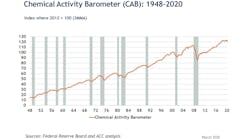The Chemical Activity Barometer (CAB), a leading economic indicator created by the American Chemistry Council (ACC), fell 2.6% in March on a three-month moving average (3MMA) basis following a downwardly revised 0.1% gain in February.
On a year-over-year (Y/Y) basis, the barometer fell 1.3% in March. The unadjusted data shows an 8.0% decline in March following a 1.1% decline in February and a 1.2% gain in January. The unadjusted decline in March is the largest in the post-World War II period.
The diffusion index slumped to 27% in March. The diffusion index marks the number of positive contributors relative to the total number of indicators monitored. The CAB reading for February was revised downward by 1.13 points and that for January was revised downward by 0.38 points.
“The CAB signals recessionary conditions in U.S. commerce,” said Kevin Swift, chief economist at ACC. “ACC believes a recession to be occurring when the barometer declines for three consecutive months and falls 3.0% or more from the peak. As of March, the CAB has declined for two straight months and fallen 8.9% from the peak.”
The CAB has four main components, each consisting of a variety of indicators: 1) production; 2) equity prices; 3) product prices; and 4) inventories and other indicators.
Production-related indicators generally declined in March. Trends in construction-related resins, pigments and related performance chemistry were generally negative. Plastic resins used in packaging and for consumer and institutional applications were generally negative. Performance chemistry was negative and US exports were weak. Equity prices collapsed, but were improving recently. Product and input prices declined. Inventory and other supply chain indicators were negative.
The CAB is a leading economic indicator derived from a composite index of chemical industry activity. Due to its early position in the supply chain, chemical industry activity has been found to consistently lead the US economy’s business cycle, and this barometer can be used to determine turning points and likely trends in the broader economy. Month-to-month movements can be volatile, so a three-month moving average of the CAB reading is provided. This provides a more consistent and illustrative picture of national economic trends.
Applying the CAB back to 1912, it has been shown to provide a lead of two to 14 months, with an average lead of eight months at cycle peaks as determined by the National Bureau of Economic Research. The median lead was also eight months. At business cycle troughs, the CAB leads by one to seven months, with an average lead of four months. The median lead was three months. The CAB is rebased to the average lead (in months) of an average 100 in the base year (the year 2012 was used) of a reference time series. The latter is the Federal Reserve’s Industrial Production Index.









